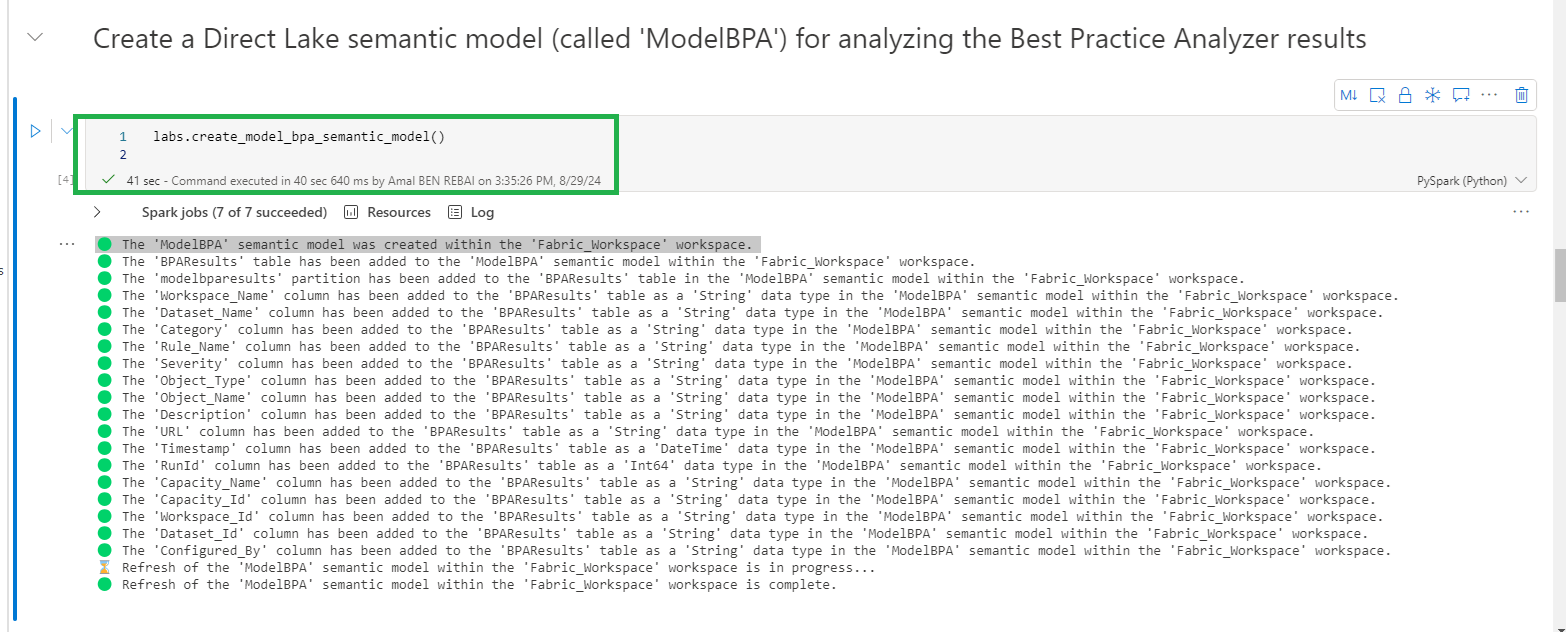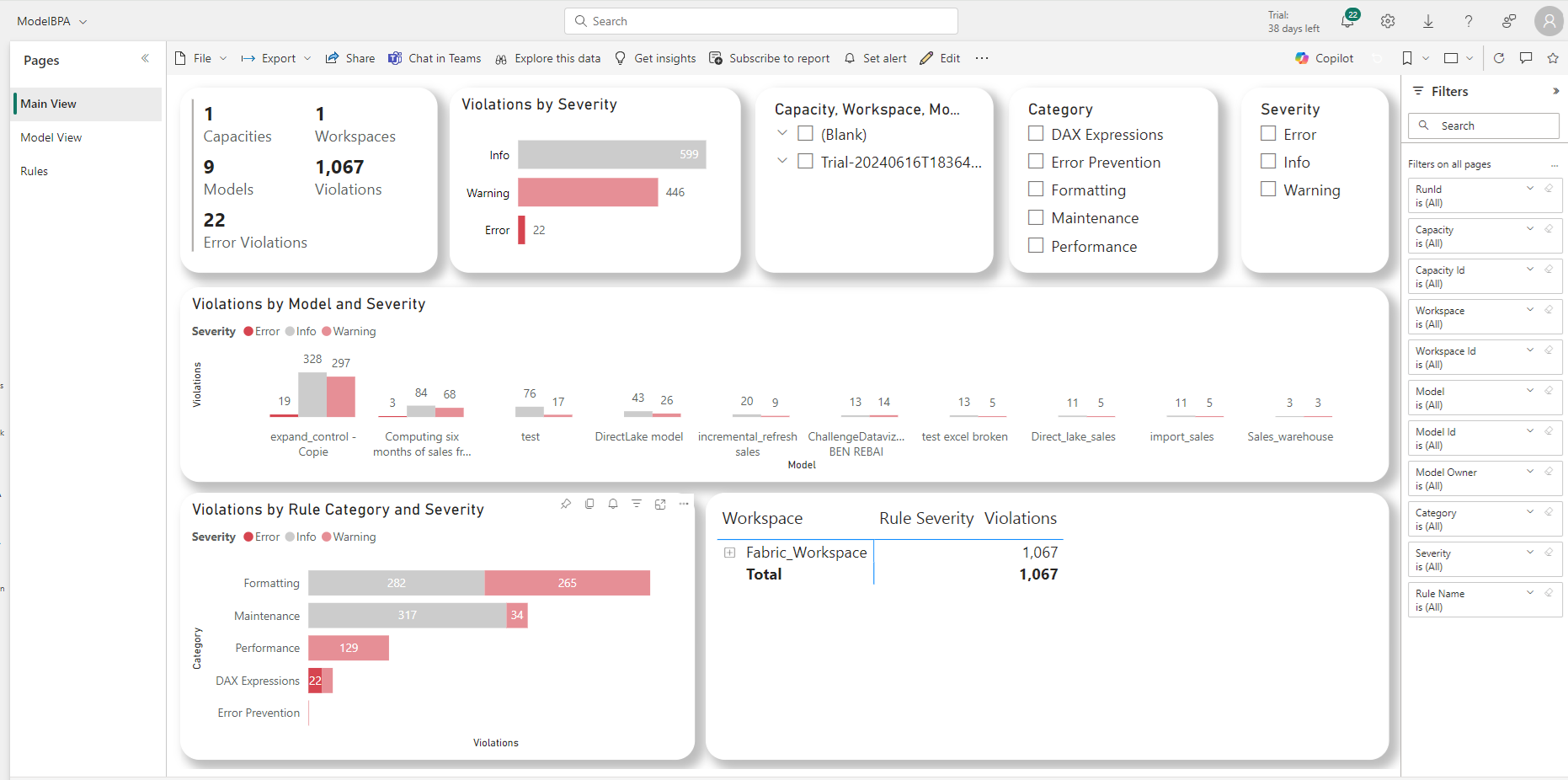𝐌𝐨𝐧𝐢𝐭𝐨𝐫 𝐒𝐞𝐦𝐚𝐧𝐭𝐢𝐜 𝐌𝐨𝐝𝐞𝐥𝐬 𝐐𝐮𝐚𝐥𝐢𝐭𝐲 𝐰𝐢𝐭𝐡 𝐁𝐞𝐬𝐭 𝐏𝐫𝐚𝐜𝐭𝐢𝐜𝐞 𝐀𝐧𝐚𝐥𝐲𝐳𝐞𝐫 𝐯𝐢𝐚 𝐒𝐞𝐦𝐚𝐧𝐭𝐢𝐜 𝐋𝐢𝐧𝐤 𝐋𝐚𝐛𝐬
With the recent release of Semantic-Link-Labs, Michael Kovalsky has introduced a streamlined approach to monitoring the quality of 𝐦𝐮𝐥𝐭𝐢𝐩𝐥𝐞 𝐬𝐞𝐦𝐚𝐧𝐭𝐢𝐜 𝐦𝐨𝐝𝐞𝐥𝐬 𝐚𝐜𝐫𝐨𝐬𝐬 𝐦𝐮𝐥𝐭𝐢𝐩𝐥𝐞 𝐰𝐨𝐫𝐤𝐬𝐩𝐚𝐜𝐞𝐬 using the Best Practice Analyzer tool.
👇👇Below, I’ve executed the following three 𝐧𝐞𝐰 Semantic-Link-Labs 𝐟𝐮𝐧𝐜𝐭𝐢𝐨𝐧𝐬 in a Fabric Notebook :
1- 𝐑𝐮𝐧𝐧𝐢𝐧𝐠 𝐭𝐡𝐞 𝐁𝐏𝐀 𝐀𝐜𝐫𝐨𝐬𝐬 𝐀𝐥𝐥 𝐌𝐨𝐝𝐞𝐥𝐬:
By using the 𝐫𝐮𝐧_𝐦𝐨𝐝𝐞𝐥_𝐛𝐩𝐚_𝐛𝐮𝐥𝐤() function, we can execute the Best Practice Analyzer across all semantic models in a workspace, or even across all accessible workspaces.
The results are efficiently saved and appended to the ‘𝐦𝐨𝐝𝐞𝐥𝐛𝐩𝐚𝐫𝐞𝐬𝐮𝐥𝐭𝐬’ delta table in the lakehouse attached to the notebook.
2- 𝐆𝐞𝐧𝐞𝐫𝐚𝐭𝐢𝐧𝐠 𝐚 𝐒𝐞𝐦𝐚𝐧𝐭𝐢𝐜 𝐌𝐨𝐝𝐞𝐥 𝐟𝐨𝐫 𝐁𝐏𝐀 𝐑𝐞𝐬𝐮𝐥𝐭𝐬:
We can utilize the 𝐜𝐫𝐞𝐚𝐭𝐞_𝐦𝐨𝐝𝐞𝐥_𝐛𝐩𝐚_𝐬𝐞𝐦𝐚𝐧𝐭𝐢𝐜_𝐦𝐨𝐝𝐞𝐥() function, which will dynamically generate a DirectLake semantic model based on the data in the ‘𝐦𝐨𝐝𝐞𝐥𝐛𝐩𝐚𝐫𝐞𝐬𝐮𝐥𝐭𝐬’ delta table.
3-𝐂𝐫𝐞𝐚𝐭𝐢𝐧𝐠 𝐚 𝐁𝐏𝐀 𝐑𝐞𝐩𝐨𝐫𝐭:
Finally, we employed the 𝐫𝐞𝐩𝐨𝐫𝐭.𝐜𝐫𝐞𝐚𝐭𝐞_𝐦𝐨𝐝𝐞𝐥_𝐛𝐩𝐚_𝐫𝐞𝐩𝐨𝐫𝐭() function to dynamically generate a Best Practice Analyzer report.
The report is connected to the previous generated semantic model.
👏👏The outcome is truly impressive. The generated report is extremely useful for ongoing monitoring and improvement of semantic models’ quality across workspaces. It allows teams to proactively address issues, ensuring high standards are consistently met.
✨It is an invaluable tool for monitoring and analyzing the quality of semantic models across various workspaces, ensuring adherence to best practices.






